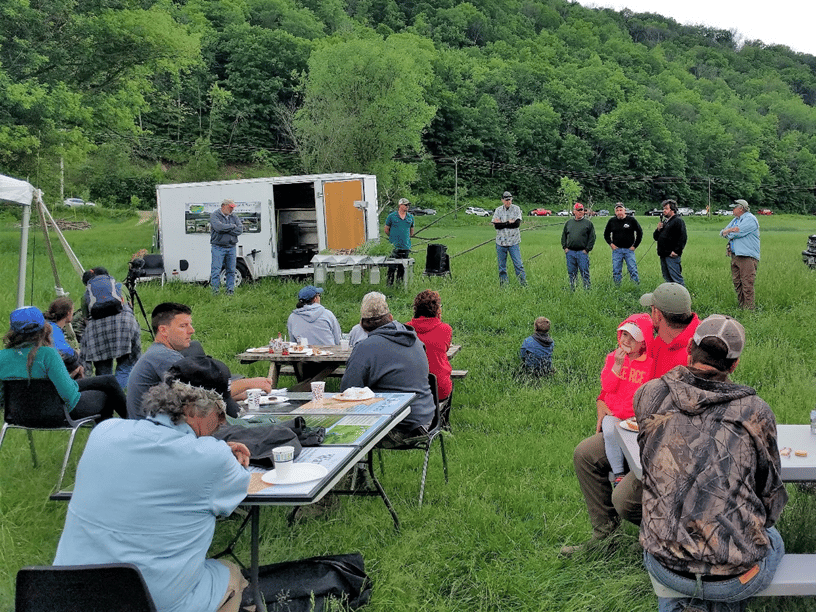Funded Project
2021 | Valley Stewardship Network – Kickapoo, Bad Axe Watersheds

Contact
Lead Entity: Valley Stewardship Network
Contact: Shelly Gradwell-Brenneman
Email: shelly@valleystewardshipnetwork.org
Project
Neighbors for Clean Water
How Local Farmers and Landowners Are Restoring Streams and Strengthening Communities
Southwest Wisconsin’s Kickapoo and Bad Axe watersheds are at a critical juncture. Nutrient and sediment runoff from agricultural and rural lands—exacerbated by increasingly severe weather events—has degraded water quality, impacted cold-water fisheries, and challenged farm viability. In the past two decades, the region has experienced multiple major floods, including a federally declared disaster in 2018.
Despite these challenges, the region is experiencing a surge in grassroots conservation leadership. Farmers and landowners are actively seeking support to implement regenerative practices that protect their land and water. This project builds years of support from Fishers & Farmers to meet that demand—expanding farmer-led watershed councils, scaling up prairie STRIPS and other BMPs, supporting youth education, and launching a new regional regenerative agriculture council.

Expanding Farmer- and Landowner-Led Watershed Councils
With support from Fishers & Farmers, Valley Stewardship Network (VSN) has helped launch and grow successful watershed councils in the Tainter Creek and West Fork watersheds. These councils have implemented a wide range of conservation practices—from cover crops and rotational grazing to bird and pollinator surveys, water sampling, and whole-farm planning.
This project expanded that model by supporting new councils in the Bad Axe, Coon Creek, and Rush Creek watersheds, and helped establish the Hill Country Watershed Alliance—a regional umbrella group that now coordinates efforts across all local councils.

Scaling Native Prairie STRIPS and Demonstration Sites
Prairie STRIPS has become one of the most effective and popular BMPs in the region. Over the course of the project, VSN developed, demonstrated, monitored, and promoted prairie STRIPS by planting over 61 acres across 11 sub-watersheds. These installations are now being harvested for local seed, capturing sediment from upslope fields, and providing habitat and drought-tolerant forage.
A high-visibility demonstration site near the City of Viroqua was also developed to showcase how native plantings can mitigate runoff from both agricultural and urban sources. Outreach included signage, media coverage, and comparative analysis of runoff and habitat conditions.
Regenerative BMP Cost Share for Council Farmers
Building on momentum from the Wallace Center Pasture Project, this initiative expanded cost-share opportunities for BMPs such as cover crops, prairie STRIPS, and who

le-farm stewardship planning. VSN developed an equitable and efficient cost-share process adaptable to a range of project sizes.
Innovative practices included the use of a goat and sheep herd for invasive species management, which grazed four sites across three watersheds. This effort trained 20 volunteer “herders” and generated strong community engagement.
Youth Regenerative Agriculture Education
VSN supported high school agriculture students and FFA members in pursuing Supervised Agricultural Experience (SAE) projects in regenerative agriculture. Students implemented cover crops, inter-seeding, and grazing practices, supported by mentorship, materials, and access to farmland. Two youth field days were held in 2022 with students from Western Technical College.
Southwest Wisconsin Regenerative Agriculture Council Development
Recognizing growing interest beyond current watershed boundaries, this project supported the formation of a regional regenerative agriculture council—a “council of councils.” This new body connects producers across the region to share knowledge, conduct research, and promote regenerative practices. A key innovation was the creation of a Technical Advisory Group (TAG) composed of five members representing diverse farming systems. This group serves as a bridge between local producers, VSN’s data collection, and university research partners, helping translate science into actionable on-farm practices.
The council focuses on five core soil health principles:
- Keep soil covered
- Minimize disturbance
- Maintain living roots
- Diversify crop rotations
- Integrate livestock
Performance and Measurable Outcomes
From 2021 to 2023, VSN:
- Provided technical assistance and coordination for five watershed councils and the Hill Country Watershed Alliance.
- Facilitated over 70 council meetings and 23 field days.
- Installed 61+ acres of prairie STRIPS across 11 sub-watersheds.
- Conducted whole-farm planning, grazing plans, and soil quality assessments.
- Developed a bird-friendly farming program and a cover crop air seeder.
- Installed in-field and watershed perimeter signage.
- Used the Fishers & Farmers rainfall simulator for a 2-day cover crop field day.
- Monitored water quality monthly at 26 sites across five watersheds, measuring phosphorus, nitrogen, dissolved oxygen, transparency, and temperature.
Outreach and Education
VSN coordinated a robust outreach strategy including:
- Field days, workshops, and pasture walks (ranging from 20 to 400+ attendees)
- Social media campaigns and local media coverage (e.g., WPR, Agri-View)
- Educational signage at demonstration sites
- Targeted GIS-based mailings
- Presentations at regional and national conservation events
This project represents a transformative step forward in farmer-led conservation. By expanding watershed councils, scaling prairie STRIPS, supporting regenerative BMPs, engaging youth, and launching a regional regenerative agriculture council, this work—made possible by years of support from Fishers & Farmers—has strengthened land stewardship, improved water quality, and built a resilient, community-driven model for conservation in working landscapes. Feedback from event surveys directly shaped programming, ensuring outreach remains relevant and responsive to community needs.


